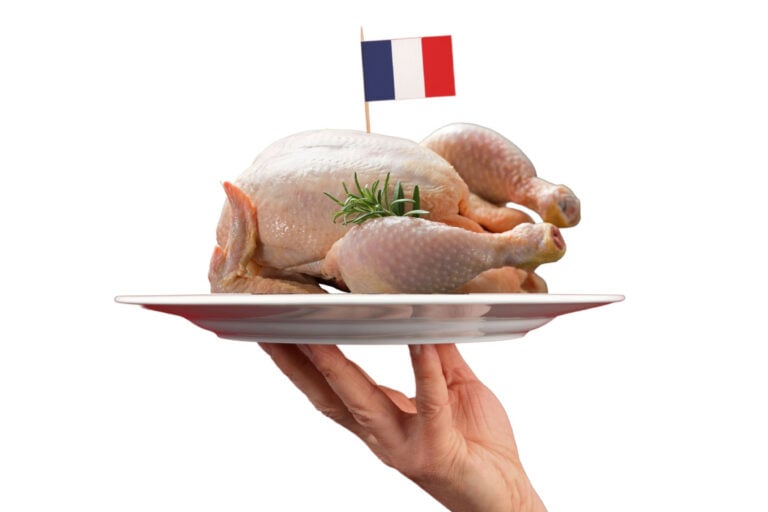November 10, 2025 | 16:59 GMT +7
November 10, 2025 | 16:59 GMT +7
Hotline: 0913.378.918
November 10, 2025 | 16:59 GMT +7
Hotline: 0913.378.918

Anvol believes that supermarkets and all other shops, restaurants, bars, fast food chains and every other premise where chicken is sold or used should mention the origin of that meat so that consumers who want French chicken can find French chicken. Photo: Canva.
The French ate 31.6 kgs of chicken, duck or turkey, compared to 31 kgs of pork and charcuterie. Poultry meat consumption grew by 10% year-on-year and by some 15% since 2019.
Encouraging news for the national poultry industry, says Anvol, the French interprofessional organisation for the poultry industry. “We have been able to regain some territory, but national production is still far from sufficient to meet ever-growing demand.”
France still needs to import ever larger quantities of chicken, which, according to Anvol, often comes from countries that do not respect the high standards that French producers must adhere to.
Two sides to a coin
“Chicken is still affordable, easy to cook or otherwise prepare, and is volatile,” Anvol vice-president Patrick Pageard said. “The success is a story with 2 sides, however. Thanks to the vaccination campaign we’ve had in France, the sector have been able to regain its position after a number of bad years because of the outbreaks of avian influenza. However, the modest growth in production is not sufficient to offer everybody the French chicken or duck they want.”
Although the import of poultry last year was lower than in 2023, it is still at an extremely high level, Anvol thinks. Over 4 of all pieces of poultry consumed are imported. For chicken, that’s almost half. Over the last 5 years, the amount of imported chicken has grown by 37% to 222,000 tonnes.
A dependance on imports
The French State Council recently said in a report that the national market is increasingly dependent on imports. Among the foreign suppliers, Poland multiplied the quantity it sold to France by 5 since 2010, while Germany, Belgium and the Netherlands also supply the French with more chicken. As a result, the trade balance for poultry and poultry meat preparations has showed a massive shortfall of €1.251 billion. “All our efforts to improve the situation haven’t had any effect at all,” Anvol warns.
To fight those massive imports and increase national supply, Anvol and other players in the French poultry sector ask that all actors, the authorities as well as the general public come together in a mobilisation to increase national production. The organisation earlier calculated that 400 new poultry sheds are needed to reach its goal. “That’s one building per year in all of the 99 departments.”
Let the origin of poultry meat be known
Anvol also asks the government to put a stop on the imports of chicken and other poultry from countries where the production conditions would be forbidden in France. France should also stop gold-plating the European rules and regulations, something current minister of agriculture Annie Genevard has already promised. Last demand: supermarkets, all other shops, restaurants, bars, fast food chains and every other premise where chicken is sold or used should mention the origin of that meat so that those consumers who want French chicken can find it.
(Poultryworld)

(VAN) The Vietnamese tilapia industry is only in the initial stages of export, yet its growth potential remains vast. To reach further, it needs to focus on breed stock, technology, and deep processing.
/2025/11/08/3402-1-212706_176.jpg)
(VAN) Viet Nam's fruit and vegetable exports continued to reach an extremely high turnover in October. With this growth momentum, the sector is expected to set a new milestone of USD 8.5 billion in 2025.
/2025/11/08/4950-1-163820_289.jpg)
(VAN) During the 2021–2025 period, Viet Nam's agro-forestry-fishery processing industry has made remarkable progress, achieving an average growth rate of 8%/year.

(VAN) Over 80 years, Vietnamese rice has journeyed through half a century to become a symbol of knowledge, resilience, and the new nation’s agriculture stature.

(VAN) The traders estimated that the lowest price in the tender, closed on Thursday by Bangladesh's state grain buyer, to buy 50,000 metric tonnes of rice was $355.59 per metric ton CIF, liner out.

(VAN) The information shared by Dr. Ngo Xuan Nam, Deputy Director of Viet Nam Sanitary and Phytosanitary Notification Authority and Enquiry Point (SPS Viet Nam), on October 30 during a conference on food safety regulations.

(VAN) Viet Nam mainly exports raw Bat Do bamboo shoots for deep processing, so premium products appear only on dining tables in Japan and Taiwan.